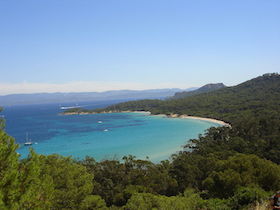Young
researchers are encouraged to apply for grants to attend the summer
school. We plan to schedule several short talks or poster sessions. If
they are interested they should send a CV and an abstract to yannick.sire@univ-amu.fr
Organizers
List of participants
How to reach the Island of Porquerolles
The simplest option is to go to Marseille (either by train to Saint-Charles station or by plane to the Marseille-Marignagne airport). Then take a train from Marseille to the city of Hyeres (tickets can be booked on the SNCF website). Finally, take a bus to Tour Fondue, which is the port of Hyeres where you can find the boats for the island. The schedule of the boats can be found at this website.
Courses
- Determinantal Point Process, Alexander Bufetov (I2M CNRS)
Determinantal point processes naturally appear in many problems of
representation theory, asymptotic combinatorics and mathematical
physics, especially, the theory of random matrices. They have recently
become an extremely active area of research. The course will give an
elementary introduction to determinantal point processes. Some open
problems will be formulated.
- Gene Wayne (Boston University)
Lecture 1: The Oseen vortex
This lecture will focus on the Oseen vortex, an explicit solution of
the two-dimensional Navier-Stokes equation. Using methods from
dynamical systems theory I will explain how one can prove that any
solution of the Navier-Stokes equation whose initial vorticity
distribution is integrable will asymptotically approach an Oseen
vortex. These are results originally obtained in collaboration
with Th. Gallay.
Lecture 2: Vortex models for two-dimensional viscous flows
Building on the classical point vortex models of inviscid
two-dimensional fluids and utilizing the insights from Lecture 1 I will
describe how one can develop models which systematically incorporate
viscosity and finite core size of the vortices. These models also
lead to new computational models for studying two-dimensional
fluids. These
results were originally obtained in collaboration with A. Barbara, R. Nagem, G. Sandri and D. Uminsky.
Lecture 3: Classical mechanics and point vortex methods
Returning to the classical point vortex model I will explain its
interpretation as a classical mechanical Hamiltonian system and explain
how techniques originally developed to study the N-body problem in
celestial mechanics can be modified to prove the existence of new
classes of solutions of the point-vortex model, and also to analyze the
stability of these solutions. This is joint work with A. Barry
and G.R. Hall.
- Nonlocal problems and applications, Enrico Valdinoci (Berlin)
We would like to consider some nonlocal problems of fractional type
that arise in differential equations and geometric measure theory. In
particular, we would like to discuss the following topics:
- Nonlocal phase transition equations: symmetry, rigidity, density estimates and asymptotics;
- Nonlocal minimal surfaces: regularity and asymptotics;
- Nonlocal Schroedinger equation: motivations and concentration phenomena;
- Crystal
dislocations: the Peierls-Nabarro model, macroscopic behavior,
attractive and repulsive potentials, dislocation dynamics.
- Ergodic optimization and joint spectral radius, Oliver Jenkinson (London)
This course will cover various aspects of ergodic optimization (i.e.
the study of optimizing ergodic averages), with particular emphasis on
applications to joint spectral radius problems.
|
|

